Astrocytes respond to a neurotoxic Aβ fragment with state-dependent Ca2+ alteration and multiphasic transmitter release
- PMID: 33726852
- PMCID: PMC7968286
- DOI: 10.1186/s40478-021-01146-1
Astrocytes respond to a neurotoxic Aβ fragment with state-dependent Ca2+ alteration and multiphasic transmitter release
Abstract
Excessive amounts of amyloid β (Aβ) peptide have been suggested to dysregulate synaptic transmission in Alzheimer's disease (AD). As a major type of glial cell in the mammalian brain, astrocytes regulate neuronal function and undergo activity alterations upon Aβ exposure. Yet the mechanistic steps underlying astrocytic responses to Aβ peptide remain to be elucidated. Here by fluorescence imaging of signaling pathways, we dissected astrocytic responses to Aβ25-35 peptide, a neurotoxic Aβ fragment present in AD patients. In native health astrocytes, Aβ25-35 evoked Ca2+ elevations via purinergic receptors, being also dependent on the opening of connexin (CX) hemichannels. Aβ25-35, however, induced a Ca2+ diminution in Aβ-preconditioned astrocytes as a result of the potentiation of the plasma membrane Ca2+ ATPase (PMCA). The PMCA and CX protein expression was observed with immunostaining in the brain tissue of hAPPJ20 AD mouse model. We also observed both Ca2+-independent and Ca2+-dependent glutamate release upon astrocytic Aβ exposure, with the former mediated by CX hemichannel and the latter by both anion channels and lysosome exocytosis. Our results suggest that Aβ peptide causes state-dependent responses in astrocytes, in association with a multiphasic release of signaling molecules. This study therefore helps to understand astrocyte engagement in AD-related amyloidopathy.
Keywords: ATP; Alzheimer’s disease; Glutamate; Hemichannel; Lysosome.
Conflict of interest statement
The authors declare that they have no competing interests.
Figures

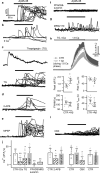

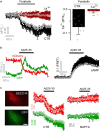
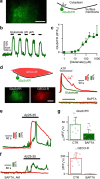
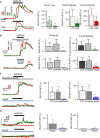
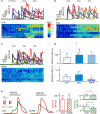
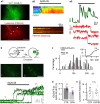
Similar articles
-
Amyloid-β-induced alteration of fast and localized calcium elevations in cultured astrocytes.Sci Rep. 2025 May 29;15(1):18944. doi: 10.1038/s41598-025-03931-7. Sci Rep. 2025. PMID: 40442293 Free PMC article.
-
Alzheimer's amyloid beta-peptide enhances ATP/gap junction-mediated calcium-wave propagation in astrocytes.Neuromolecular Med. 2003;3(3):173-80. doi: 10.1385/NMM:3:3:173. Neuromolecular Med. 2003. PMID: 12835512
-
Apoptosis induced by Aβ25-35 peptide is Ca(2+) -IP3 signaling-dependent in murine astrocytes.Eur J Neurosci. 2014 Aug;40(3):2471-8. doi: 10.1111/ejn.12599. Epub 2014 May 15. Eur J Neurosci. 2014. PMID: 24827147
-
Calcium signals induced by amyloid beta peptide and their consequences in neurons and astrocytes in culture.Biochim Biophys Acta. 2004 Dec 6;1742(1-3):81-7. doi: 10.1016/j.bbamcr.2004.09.006. Biochim Biophys Acta. 2004. PMID: 15590058 Review.
-
Astrocytes in Alzheimer's disease: emerging roles in calcium dysregulation and synaptic plasticity.J Alzheimers Dis. 2010;22(3):699-714. doi: 10.3233/JAD-2010-101089. J Alzheimers Dis. 2010. PMID: 20847426 Review.
Cited by
-
Store-Operated Calcium Entry Inhibition and Plasma Membrane Calcium Pump Upregulation Contribute to the Maintenance of Resting Cytosolic Calcium Concentration in A1-like Astrocytes.Molecules. 2023 Jul 12;28(14):5363. doi: 10.3390/molecules28145363. Molecules. 2023. PMID: 37513235 Free PMC article.
-
APOE4 genotype and aging impair injury-induced microglial behavior in brain slices, including toward Aβ, through P2RY12.Mol Neurodegener. 2024 Mar 11;19(1):24. doi: 10.1186/s13024-024-00714-y. Mol Neurodegener. 2024. PMID: 38468308 Free PMC article.
-
Alzheimer and Purinergic Signaling: Just a Matter of Inflammation?Cells. 2021 May 20;10(5):1267. doi: 10.3390/cells10051267. Cells. 2021. PMID: 34065393 Free PMC article. Review.
-
STIM Proteins: The Gas and Brake of Calcium Entry in Neurons.Neurosci Bull. 2025 Feb;41(2):305-325. doi: 10.1007/s12264-024-01272-5. Epub 2024 Sep 12. Neurosci Bull. 2025. PMID: 39266936 Review.
-
Calcium Signaling in Astrocytes and Its Role in the Central Nervous System Injury.Mol Neurobiol. 2025 May 26. doi: 10.1007/s12035-025-05055-5. Online ahead of print. Mol Neurobiol. 2025. PMID: 40419752 Review.
References
-
- Alberdi E, Wyssenbach A, Alberdi M, Sanchez-Gomez MV, Cavaliere F, Rodriguez JJ, Verkhratsky A, Matute C. Ca(2+)-dependent endoplasmic reticulum stress correlates with astrogliosis in oligomeric amyloid beta-treated astrocytes and in a model of Alzheimer's disease. Aging Cell. 2013;12:292–302. doi: 10.1111/acel.12054. - DOI - PubMed
Publication types
MeSH terms
Substances
LinkOut - more resources
Full Text Sources
Other Literature Sources
Medical
Research Materials
Miscellaneous

